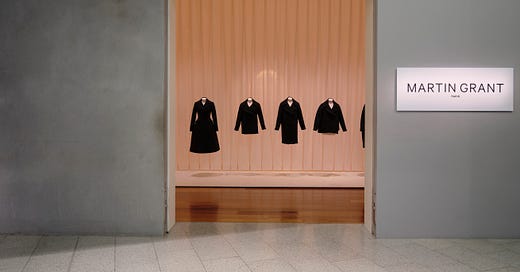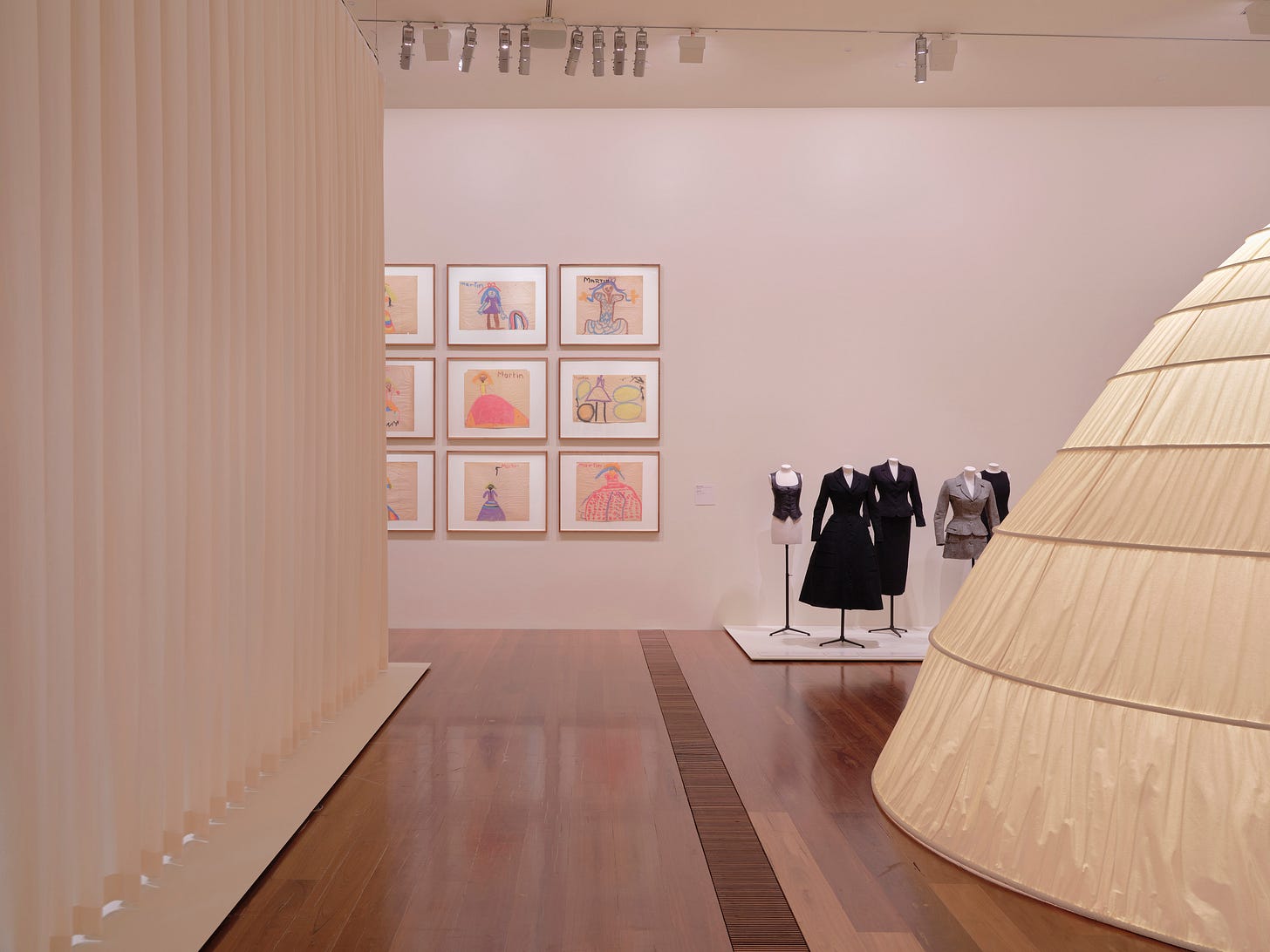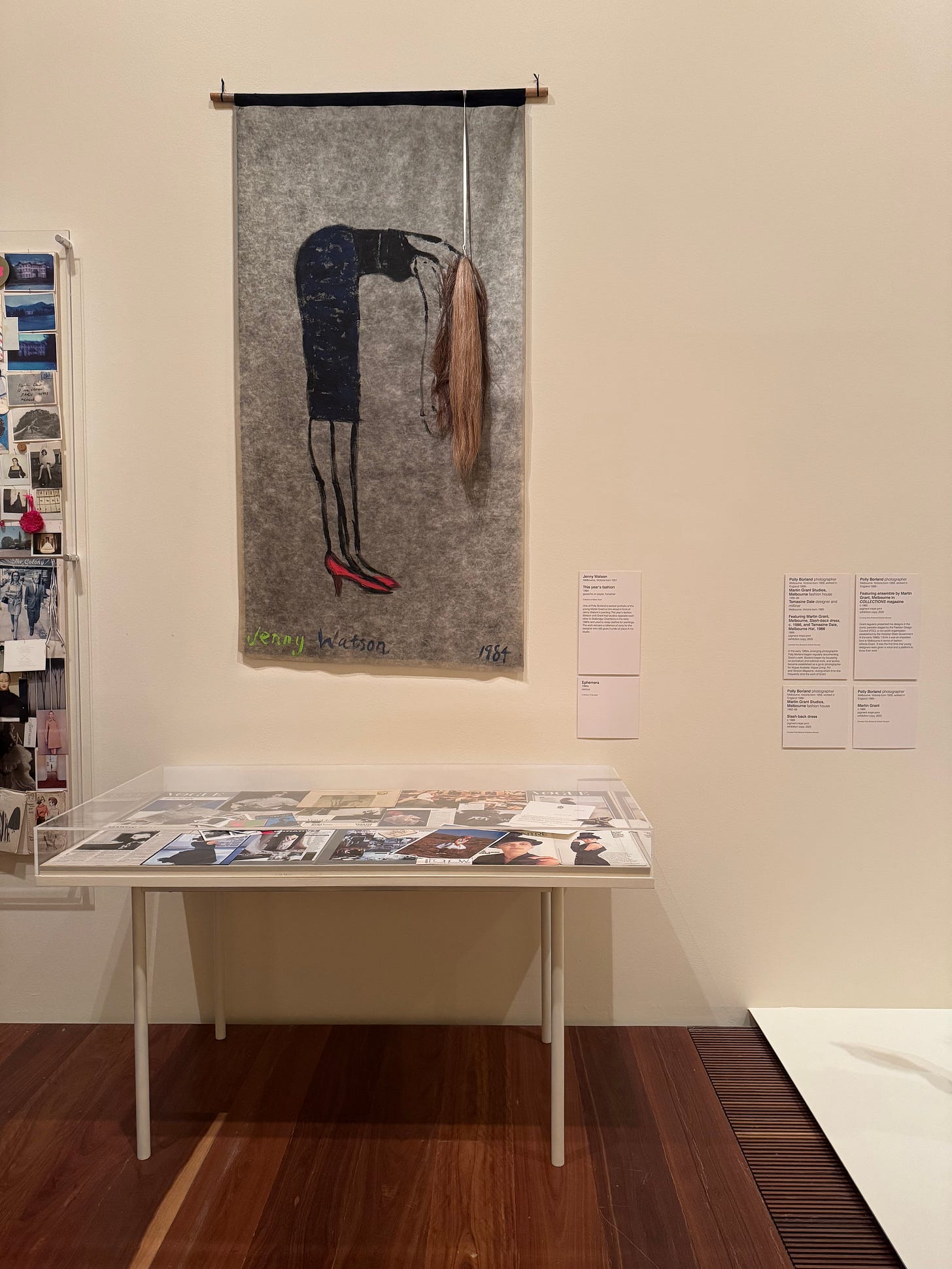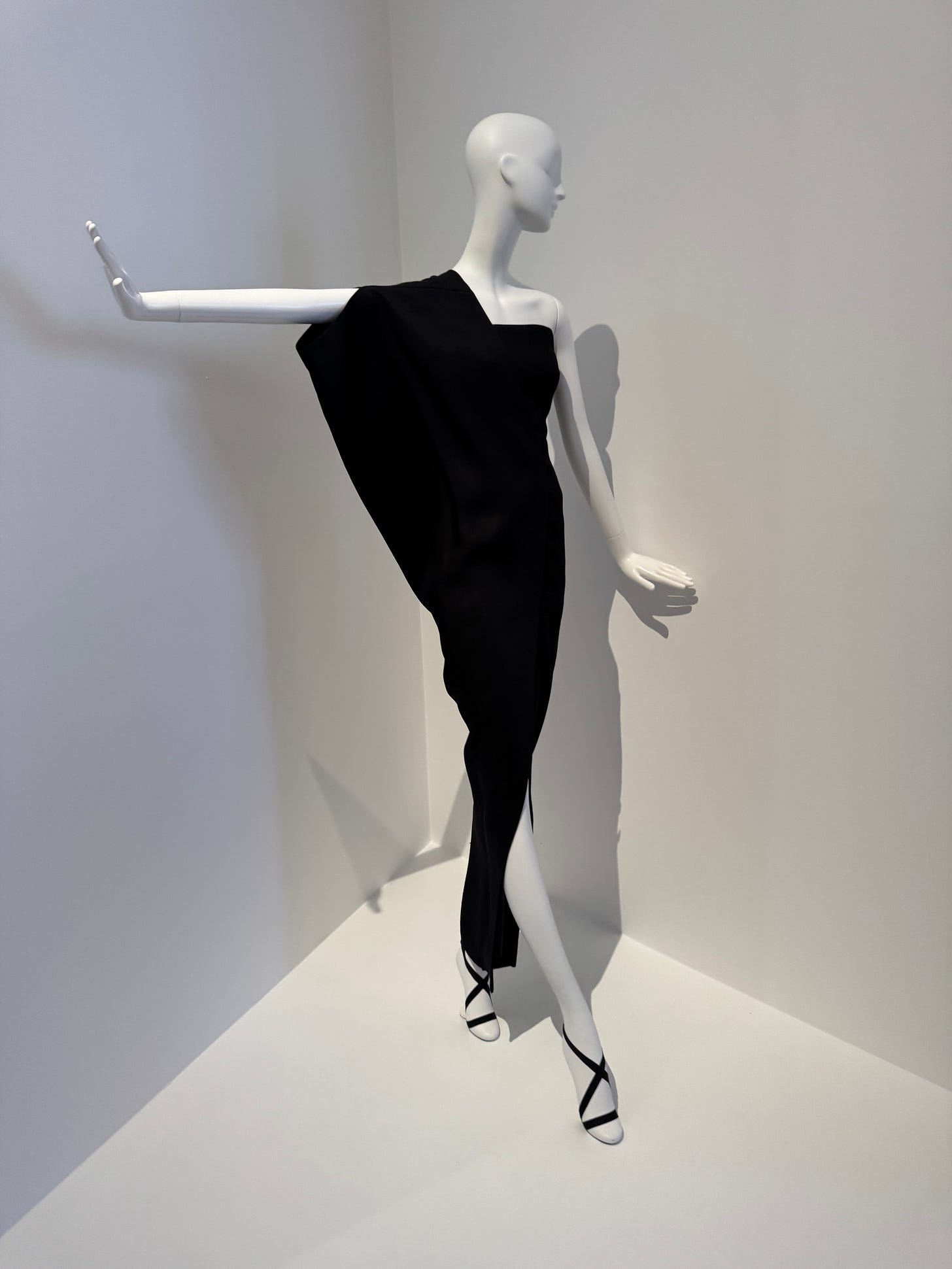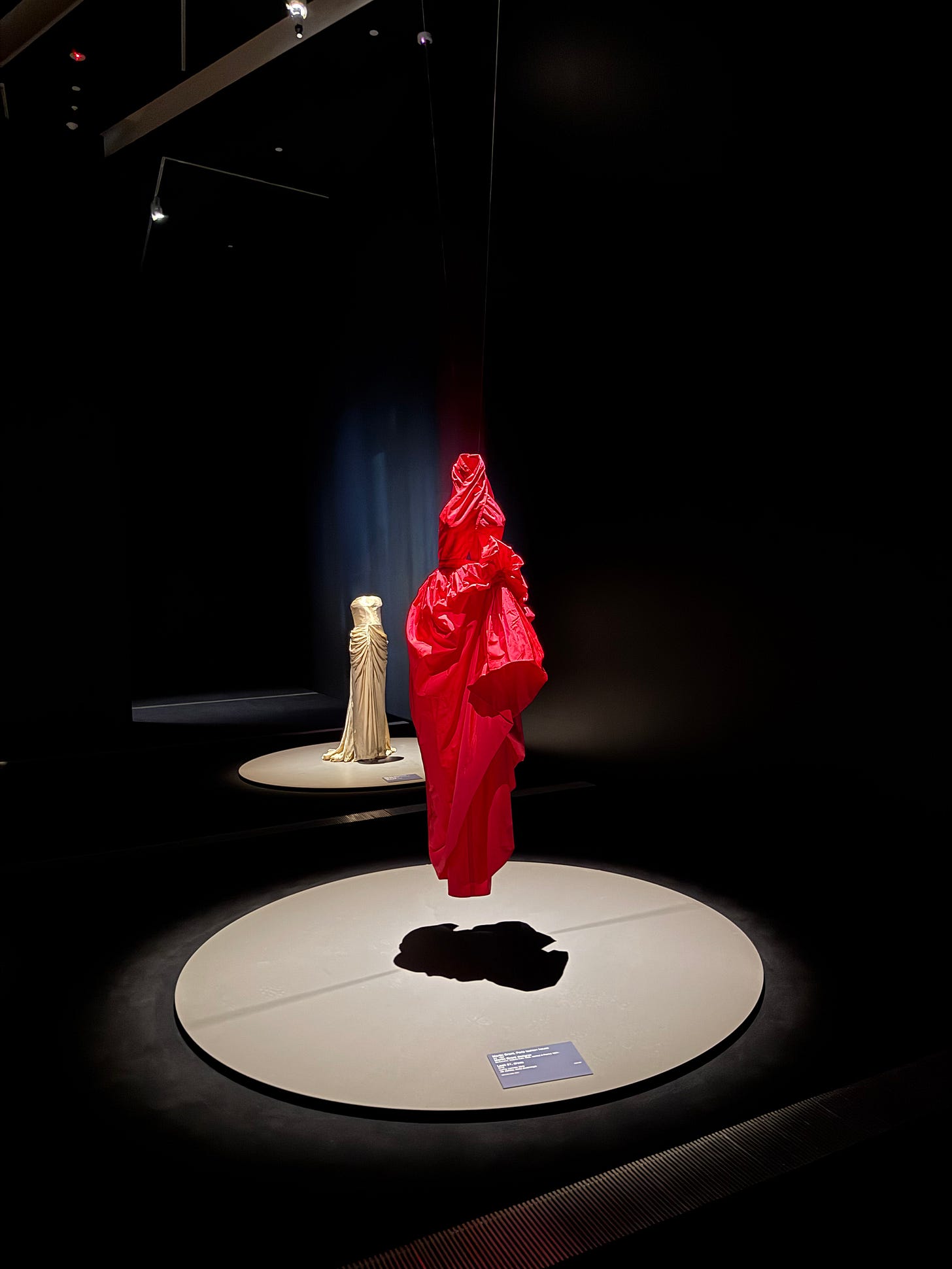The Martin Grant retrospective at the National Gallery of Victoria’s Ian Potter Centre opens with a line of six black coats. Each one a different, perfect silhouette, suspended in front of a cream curtain. Katie Somerville, the museum’s senior fashion curator, describes his coats as, “hard to go past… there are lots of elements that really stand out for me, but I think the coats are something quite special.”
Grant was born in Melbourne but has lived in France for long enough to be considered Parisian. His career is impressive and storied. He has shown on schedule at Paris Fashion Week, worked as the creative director for Barney’s New York, counts André Leon Talley and Lee Radziwill amongst his close friends and his clothes have been worn by everyone from Lady Gaga to Cate Blanchett.
It is not an overstatement to say he has spent four decades perfecting the form and line of these six coats. So, it is a sweet touch, for the NGV to have included the paintings of a four-year-old Grant on the wall to their left. The nine paintings, done on large sheets of butcher’s paper, each feature a brightly coloured dress, revealing a talent and appreciation of fashion at – a quite frankly - ridiculously early age.
The first room is a testament to the relationships Grant forged while he was partying with other artists and designers in Melbourne in his teens and early twenties. Somerville – who gave a tour at the media preview this morning – describes Grant and the artist Jenny Watson exchanging clothes for a painting during this period. The painting has travelled with him all the way to Paris and back again for the exhibition, it remains a cherished piece of artwork. The artist Rosslynd Piggott - another friend of Grant’s from those days – is also in attendance. She has leant garments to the exhibition and as I am marvelling at a gold coat in another room, she appears beside me and says, “that one’s mine.”
Friendships and creative partnerships forged at dive bars and on sweaty dance floors are a constant theme when I interview fashion designers. They were especially notable during the interviews I did for the NGV’s Alexander McQueen exhibition - when I asked each collaborator how they met him – the answer was always at the club.
The stories Grant’s friends shared - Christine Barro who stocks Grant at her boutique on Collins Street told me she used to dance topless in her party days with Grant - remind me of being a student at RMIT and running between Third Class, St Jerome’s, The Toff and Carlton Club. It was of course, the height of indie sleaze so we would occasionally venture south-side to hit up Shake Some Action at One-Six-One. The friends I made during those times still inform my work and career decisions today, even when, like Grant’s, they are scattered all over the world.
As I move through the retrospective it strikes me how exquisite his clothes are – that Somerville describes them as being influenced by his childhood makes sense. He makes clothes with exquisite natural materials and the kind of attention to detail in construction and form that makes them feel like heirlooms. These things are sadly under threat as mass production and synthetics infiltrate even luxury fashion houses.
In a long white room designed to showcase what it’s like to be a client in Grant’s atelier in the Marais, there is a series of black dresses that showcase his brief training as a sculptor at the Victorian College of the Arts. My favourite is an asymmetric cocktail dress with a strapless corset as the anchor. Just one shoulder is covered by draping that creates an elbow length batwing sleeve and falls into a calf-length skirt which is anchored on the opposite hip by a vertical line of black, covered buttons. It is made from wool.
The loss of this type of fashion - beautifully constructed natural fibres - is something I think about a lot. I’ve spoken to climate scientists who warn that if global warming continues on this trajectory, we will lose the production of silk, wool and cashmere as the landscapes that produce them will no longer exist. Garment makers with the skill to deliver the finishes in Grant’s designs are ageing, or being priced, out of the market.
As I enter the final room of the exhibition it dawns on me that we may never see clothes like this again. The room is cavernous and dark, with a series of sculptural, ethereal gowns from his runway collections spotlit against the black. This may be because I slept badly last night – but truly they are so breathtaking I have to stop myself from crying. I realise this will seem ridiculous to anyone who doesn’t care about fashion – if you’re here I’m going to assume that you do – but it does terrify me that we are hurtling towards a future where we have so thoroughly trashed the earth - with an economic system that has devalued the craft and skill of making - that soon clothes as beautiful as this may disappear.
Not because we all need to wear ball gowns, but because of what it says about the limits we’ve pushed the planet and people to. And because it’s only happening because the wrong people have been in power, protecting their own interests for too long.
Fashion is fast and cheap because it’s made from oil and rich men can get even richer by selling trash (people think of fashion as an insignificant part of the economy but three of the top ten richest men in the world make money from selling fast fashion). As an economist I spoke to recently pointed out: we get the technology that billionaires want. If they wanted to get microplastics out of the ocean, they would make it happen. If they wanted the green transition, they would make it happen. If they wanted online spaces to be safe for our mental health, they would make it happen. If they wanted to protect art and literature and journalism and beautiful clothes, they would make it happen.
In the meantime, I suggest going to see the exhibition at the NGV, because in their own way, Martin Grant’s clothes are a testament to the wonders of the natural world.
Martin Grant will be on display from 28 March 2025 – 26 Jan 2026 at The Ian Potter Centre: NGV Australia at Fed Square, Melbourne. Tickets and information are available via the NGV website: NGV.MELBOURNE


